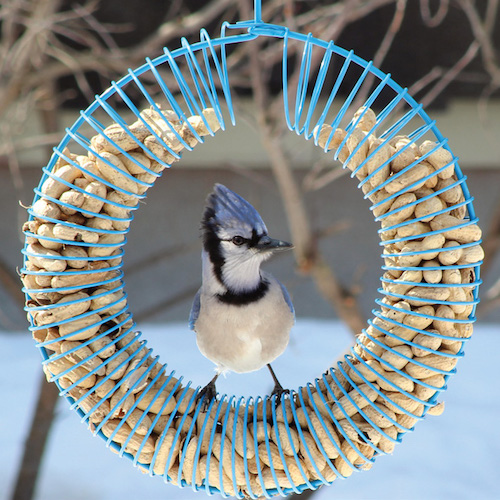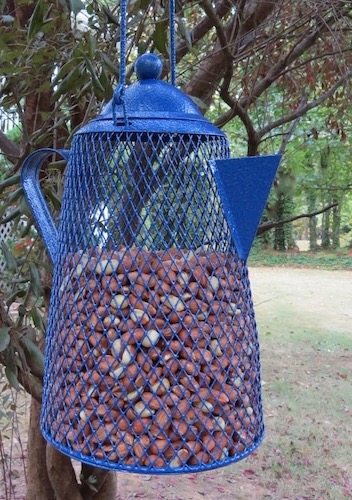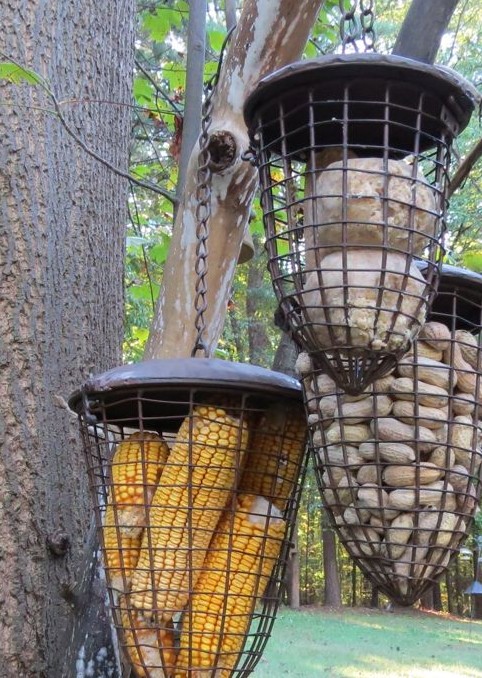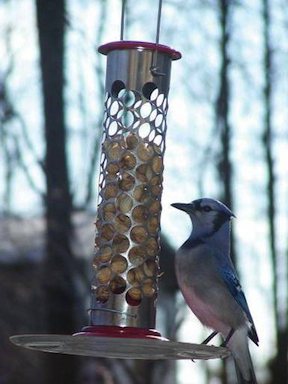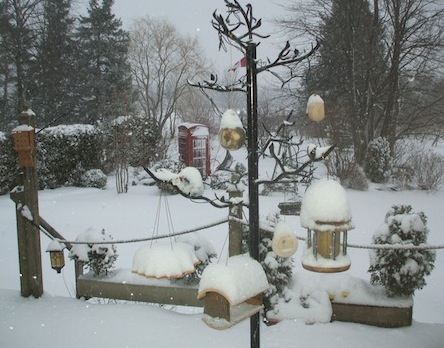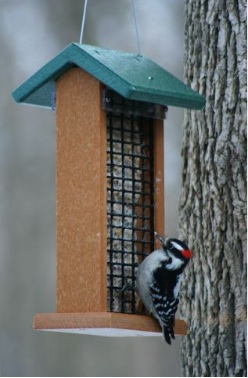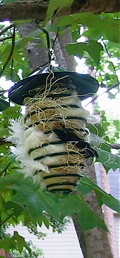-
Peanut Bird Feeders that Rock
Give birds peanuts… because variety is the spice of life!
Be it shelled or whole peanuts, birds love them and for good reason. They pack a real punch for nutrition and likely for taste, but you’d have to ask a bird on that one.
Simply put, Calories = Energy, so especially for cold weather feeding, peanut bird feeders are always a good bet. That energy is what keeps birds warm overnight. Ever wonder why many resident birds feed from dawn till dusk? The goal is to store enough energy to make it through a frigid night.
The Wreath Peanut Feeder above is meant for whole peanuts, but it’s easy to pop a suet ball or two inside for more variety. The design is very bird-friendly and even lends itself for other options.
In early spring, it’s ideal for nesting materials. Start saving your pet’s hair from their brush now. Decorative mosses and feathers are also prime materials for nest construction by most of the usual suspects. Steer clear of dryer lint- though it may seem soft & fluffy, it contains synthetic material that’s just not found in a birds’ world.
Say you could do without the mess of peanuts in the shell? Opt for a feeder that’s made for shelled peanuts. Most of these will accommodate black oil sunflower seed so you can still change it up, enticing more birds to your place.
The large capacity mesh design offers lots of all-over feeding space. Most styles also lend themselves to doing the nest materials in spring. Adding suet may not work as well in shelled peanut bird feeders as there’s nothing to hold it at the outer wall for easy access – though you’ll likely be able to do black oil sunflower for variety.
Regardless if shelled, or peanuts in the shell, birds will flock for this tasty treat year-round. Expect woodpeckers, jays, titmice, chickadees, nuthatches, bluebirds and others at shelled peanuts. Expect squirrels at all peanut feeders… in which case a baffle is highly recommended 🙂
-
Super Sized Peanut Bird Feeders
Lots of birds (and squirrels) adore whole peanuts, especially in colder weather- they pack a punch for higher nutritional value than seed alone. If you’d rather keep squirrels out of peanut bird feeders a baffle is highly recommended!
Ideal for feeding whole peanuts, this wire basket set is versatile for lots of other goodies too. Use these for suet, corn cobs, nesting materials in spring, and even fruit in summer for migratory birds. Use all 3 for peanuts and hang them in different spots around the yard to entice more feathered friends! They feature a long hanging chain with big hook for easy placement (plus enough chain length to accommodate a baffle). The locking lid will keep thieving paws out, and the solid roof helps protect goods from the elements.
There’s also a tube style stainless steel version for whole peanuts which offers an optional seed tray. Inviting more than clinging birds, jays and other can perch in comfort on the 10-inch tray while it helps to catch waste.
It’s actually dubbed as a suet ball feeder, but the large openings are perfect for whole peanuts. So you can really offer a variety of treats in one feeder, mixing some suet chunks or balls between peanuts to delight many a species! Clingers like chickadees, nuthatches, titmice and woodpeckers love this stuff, as well as jays, bluebirds and cardinals (in winter), phoebes, warblers… and the list goes on!
Branch out from traditional feeders filled with boring birdseed and see who comes to visit? And as always, fresh water is key to bringing more birds to the garden. Even during frigid weather, songbirds will absolutely flock to a heated birdbath.
-
Do More with Peanut Bird Feeders
Just a few short weeks (hopefully) and that dreary, brown, snow covered landscape will give way to lush new foliage… and it can’t come soon enough for many of us!
Feeders have been in full swing this winter with hungry birds braving the most frigid days seeking calories to keep warm. Every feeder’s seen its share of flying traffic through this most miserable season.
With bulbs forcing through, birds are already starting to nest in the southeast, we’ve already changed up two peanut bird feeders for another good use… nesting materials!
Any kind of feeder with wide openings works well. Because peanuts are still mighty beneficial to birds, using an extra suet cage is ideal for offering materials.
Here’s one of the cool things about backyard birding. Not too much is cut in stone so to speak. You needn’t buy a full-fledged peanut bird feeder to offer peanuts, nor a complete nesting material kit to offer the materials. Here’s a cool recycled 3-in-1 feeder that perfect for suet, peanuts, nesting material or even fruit in summer. Just be creative and see what works best for your birds!
That same spring feeder offers peanuts, suet, nest material, and yes… fruit in summer. Oh yeah, and the nesting materials? You can do this one yourself! Cats or dogs? Save their hair (not such a good idea if fluffy or fido has been treated with flea & tick medication). Decorative mosses are another favorite, sphagnum or sheet moss, Spanish moss, coco fibers from old plant liners too. Just be sure they’re clean. Feathers are coveted as well for some species’ nests. Again, just be sure thee have been sanitized, and use light or natural colors in the mix.
Recently cruising one of the video platforms, a big retailer’s video came up about nesting material. With lots of video views, “how dead wrong” is what came to mind. Cardinals don’t use those shelves, they nest in trees or shrubs. But I guess if you have no trees or shrubs they might use one? And they don’t use that cotton stuff either. Weed stems, twigs, bark, grasses and leaves are what make up cardinal nests in these parts… come on!

